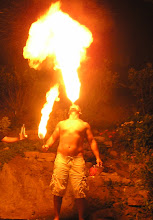Back in 2003-4, I was shopping for a house and frustrated by the rapidly rising home prices. My ex and I had purchased a house in Los Angeles in 2000 for $265K. That seemed like a crazy-high mortgage to me at the time. Now it makes me nostalgic. By the time we split in 2003, the house was worth over $400K. She sold it in late 2006 for $780K (smart woman). Now, Zillow lists the house at $561K. Good luck getting that price in today's market.
The house was on a hill side with a commanding view and the neighborhood did "pop" after we bought, so it retained more value than many homes in LA. Still, the buyer lost 28% of the home value on paper, and probably over 35% if he were to sell. Houses built in far outlaying communities at the height of the boom have lost over 50% of their value. That's if you can get anybody to buy them, which you probably can't.
The big crisis in the housing bubble burst came because too many people got mortgages who should not have. During the go-go years of the housing boom, some people were absolutely frantic to buy a home. Everybody else had one, the prices kept going up and up and up, and if you didn't own a house you could not get any of that free money falling from the sky. So crazed buyers would have bidding wars, and houses would sometimes go for 10-15% over the listing price. I suspect the winners of those bidding wars are feeling like losers now.
According to RealtyTrac, there were over 3 million foreclosure filings in 2008 (up 81% from 2007 and 225% from 2006). Banks repossessed over 850,000 properties in 2008, more than double the previous year. And 2009 is looking much worse. By the end of this year, we could have over two million repossessed homes sitting empty, waiting for meth heads to remove their fixtures and render them even less valuable. My question is...what do we do with those properties, and how can we stabilize real estate prices with that much inventory and no buyers?
One big problem is that nobody knows where the bottom is. It is entirely possible that the home that seems like a bargain today because it fell from $400K to $280K, could lose another 10 to 20% of it's value, maybe more. Who knows? That uncertainty is effecting the housing market big time. To me, the biggest challenge is those millions of empty homes. It's like gangreen has infected your foot and spread up to the ankle and knee, heading for your hip. The only solution is to cut it out. So one might conjecture that bulldozing those empty houses would decrease supply to meet demand, and stabilize prices as a result. But the banks own those houses. Even though they are upside down on each one, they cannot walk away from whatever value is in them.
According to the National Association of Realtors, the average home price in December was $213K. Let's assume that the average value of reposessed homes is much lower, say $120K. That would mean there is $240Billion of inventory on the market that, for the most part, nobody wants to buy. While we address the financial crisis, much attention has been paid to "toxic mortgages". These are typically bad loans where the home owner didn't read the fine print and the monthly mortgage payment keeps rising until they can't afford to pay it. All of that is part of the banking crisis. But nobody is talking about toxic real estate. And as long is the situation isn't addressed, I fear the gangreen will continue to spread.
Subscribe to:
Post Comments (Atom)

No comments:
Post a Comment